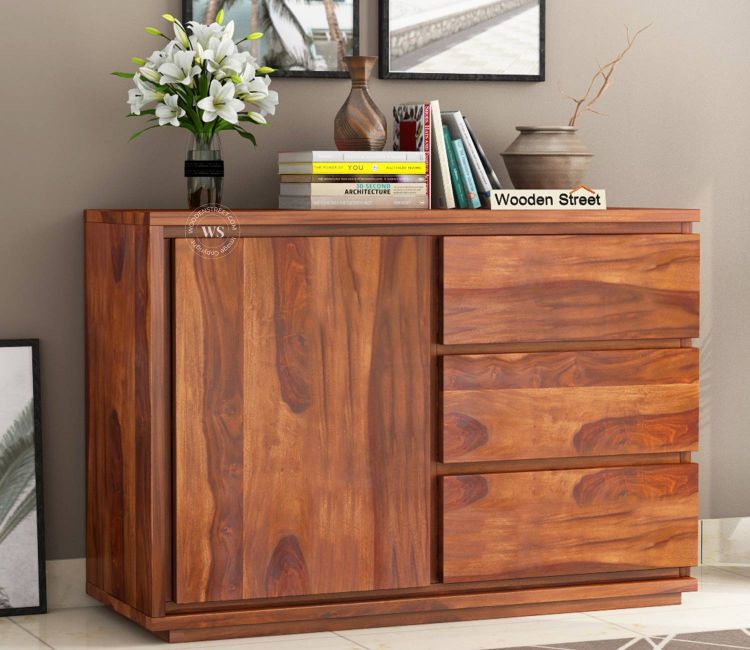verall functionality. Whether you’re aiming for a sleek modern look or a timeless traditional feel, selecting the right material ensures your chest of drawers complements your interior and stands the test of time.
In this guide, we’ll break down the most popular materials used in chest of drawers and help you decide which one best suits your space and lifestyle.
1. Solid Wood: A Timeless Classic

Best for: Durability, classic aesthetics, and long-term use
Solid wood is one of the most sought-after materials for chest of drawers. Woods like oak, sheesham, teak, and walnut are commonly used for their strength and natural beauty.
Pros:
- Highly durable and long-lasting
- Natural grains offer unique aesthetics
- Can be refinished or repaired easily
Cons:
- Heavier and more expensive than other options
- Susceptible to warping if not maintained properly
Ideal For: Traditional, rustic, and luxury interiors
2. Engineered Wood (MDF, HDF, Particle Board)
Best for: Budget-conscious buyers and modern interiors
Engineered wood like MDF (Medium-Density Fiberboard) and particle board is made by binding wood fibers or particles with adhesive. It offers a smooth finish and is widely used in budget-friendly furniture.
Pros:
- Cost-effective and lightweight
- Smooth surfaces ideal for painted finishes
- Available in a wide variety of styles
Cons:
- Less durable than solid wood
- Not ideal for very heavy loads
- Prone to swelling if exposed to moisture
Ideal For: Minimalist and contemporary spaces
3. Plywood
Best for: Balanced durability and affordability
Plywood is crafted by layering thin sheets of wood veneer, making it stronger than particle board and more affordable than solid wood. It’s a popular mid-range option for chest of drawers.
Pros:
- Good strength and stability
- Less prone to warping than solid wood
- Affordable and versatile
Cons:
- Surface may require laminates or veneers for a polished look
- Edges may need sealing or finishing
Ideal For: Mid-range furniture in family homes and rental properties
4. Metal
Best for: Industrial-style interiors and heavy-duty use
Metal chests of drawers are gaining popularity in modern, urban spaces. Often made from steel or aluminum, they offer a sleek, functional design.
Pros:
- Extremely durable and strong
- Resistant to termites and moisture
- Minimal maintenance
Cons:
- Can look cold or clinical if not styled properly
- Heavier and potentially noisier than wood
Ideal For: Industrial, modern, and urban interiors
5. Plastic or Polypropylene
Best for: Lightweight storage and temporary use
Plastic drawer units are commonly used in children’s rooms, dormitories, or for mobile storage. While they aren’t considered premium furniture, they offer convenience.
Pros:
- Lightweight and easy to move
- Moisture-resistant
- Affordable
Cons:
- Less durable and often less attractive
- Not suitable for heavy storage or long-term use
Ideal For: Kids’ rooms, garages, and temporary setups
6. Glass Accents (with Wood or Metal)
Best for: Elegant and decorative appeal
While not used as a core material, glass is often added as an accent for drawer fronts or tops. It adds a sophisticated, reflective finish to wooden or metal frames.
Pros:
- Adds a touch of elegance and shine
- Easy to clean
- Works well with both modern and vintage styles
Cons:
- Fragile and requires care
- Not suitable for rough use
Ideal For: Glamorous or designer-inspired interiors
Which One Should You Choose?
The best material for your chest of drawers ultimately depends on your priorities:
- For long-term investment: Solid wood or plywood is a wise choice.
- For affordability and style: Engineered wood is ideal.
- For modern and minimal spaces: Metal or mixed materials like glass and metal work beautifully.
- For temporary use or mobility: Plastic units serve well.
Each material has its strengths and trade-offs, so consider your lifestyle, room decor, and budget before makinga decision. A well-chosen chest of drawers not only provides essential storage but also enhances the beauty and functionality of your home.